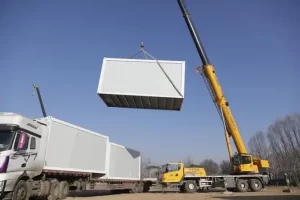In the long history of human civilization, architecture has always played a crucial role as the carrier of culture and the residence of life. From primitive caves to grand palaces, from humble huts to skyscrapers, the evolution of building forms has witnessed the progress of human wisdom and technology. However, in the pursuit of more efficient, more environmentally friendly, more personalized today, the traditional construction methods gradually revealed its limitations, and prefabricated houses as an emerging construction mode, is with its unique advantages, quietly break these constraints, leading the change of the construction industry.
Limitations of traditional construction methods
Traditional construction methods, mostly on-site manual operation, which is not only time-consuming and costly, but also susceptible to a variety of factors such as weather, labor skill level, resulting in building quality and efficiency is difficult to ensure. In addition, the traditional construction process produces a lot of construction waste and low material utilization, which is not in line with the current concept of sustainable development. In today's increasingly personalized demand, traditional construction methods are also overwhelmed by design flexibility, making it difficult to meet the market demand for diversified residential products.

Traditional construction methods are more labor-intensive
Prefabricated House: Definition and Characteristics
Prefabricated housing, also known as assembled buildings, is a form of construction in which the various components of a building (e.g., walls, floor slabs, roofs, etc.) are pre-produced and processed in a factory, then transported to the construction site, where they are assembled by means of reliable connections. The core of this method lies in the word “prefabrication”, which realizes the transfer of building production from the site to the factory, thus greatly improving construction efficiency and quality control.
Efficient and fast: the construction cycle of prefabricated houses is greatly shortened because most of the construction work has been completed in the factory, and only assembly is required on site, reducing construction time and labor costs.
Controllable quality: Factory production ensures the consistency of materials and the accuracy of components, and improves the overall quality of the building through a strict quality control system.
Environmental protection and energy saving: prefabricated houses pay more attention to environmental protection in design and material selection, and can use a large number of recycled materials or low-carbon materials to reduce the generation of construction waste, while good thermal insulation performance also reduces energy consumption.
Flexible design: Prefabricated houses are not restricted by traditional construction methods and can achieve more complex and varied designs to meet the demand for personalized housing, and can even be quickly built with different styles and functional spaces through modular design.
Economic cost: Although the initial investment may be higher due to factory construction and equipment purchase, in the long run, large-scale production can effectively reduce the unit cost, coupled with a short construction cycle and quick return of capital, the overall economic benefits are significant.
Easier way to build a prefabricated house
Click here to know more
Practices and Challenges of Prefabricated Houses
Globally, the application of prefabricated houses has been gradually popularized. From Japan's high-efficiency earthquake-resistant houses, to Europe's green eco-houses, to the U.S.'s modular villas, prefabricated houses have won market recognition for their unique advantages. In China, with the acceleration of urbanization and the government's support for green building, prefabricated houses have also ushered in unprecedented development opportunities. However, its development still faces some challenges, such as low public acceptance, inconsistent technical standards, and transportation and installation costs.
In order to overcome these challenges, joint efforts of the government, enterprises and research organizations are needed. The government should introduce more supportive policies to guide the healthy development of the industry; enterprises should increase technological innovation to improve product quality and service level; and scientific research institutions need to conduct in-depth studies on prefabricated housing materials, structures, construction techniques, etc., to promote technological progress.
Conclusion
The emergence of prefabricated houses is not only a revolution in construction technology, but also a subversion of the traditional concept of construction. It breaks the limitations of time, space, material and design, and makes the building more efficient, environmentally friendly, flexible and personalized. With the continuous progress of technology and the increasing maturity of the market, prefabricated houses are expected to become the mainstream trend of future construction, creating a better living space for human beings. In this process, we look forward to seeing more innovation and practice, and jointly promote the sustainable development of the construction industry, so that prefabricated houses become a bridge connecting the past and the future, leading us towards a better tomorrow.
Know more:https://new.qq.com/rain/a/20240712A0AJXI00
Post time: 10-15-2024









